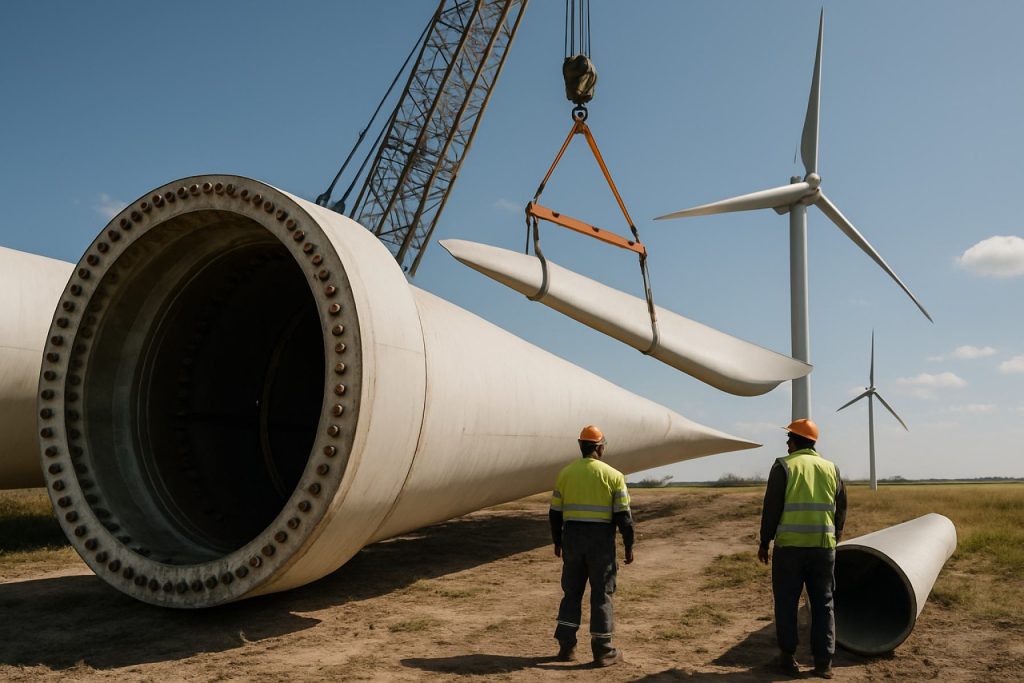
Wind Turbine Decommissioning and Upcycling Market Report 2025: In-Depth Analysis of Growth Drivers, Technology Innovations, and Global Opportunities. Explore Market Size, Key Players, and Future Trends Shaping the Industry.
- Executive Summary & Market Overview
- Key Market Drivers and Restraints
- Technology Trends in Wind Turbine Decommissioning and Upcycling
- Competitive Landscape and Leading Players
- Market Size and Growth Forecasts (2025–2030)
- Regional Analysis: North America, Europe, Asia-Pacific, and Rest of World
- Challenges and Opportunities in Decommissioning and Upcycling
- Regulatory Environment and Policy Impact
- Future Outlook and Strategic Recommendations
- Sources & References
Executive Summary & Market Overview
The wind turbine decommissioning and upcycling market is emerging as a critical segment within the broader renewable energy industry, driven by the aging of first-generation wind farms and increasing regulatory and environmental pressures. As of 2025, a significant number of wind turbines installed during the early 2000s are reaching the end of their 20-25 year operational lifespans, prompting a surge in decommissioning activities worldwide. The global wind turbine decommissioning market is projected to grow at a compound annual growth rate (CAGR) of over 10% through 2030, with Europe and North America leading due to their mature wind energy portfolios and stringent sustainability mandates (Wood Mackenzie).
Decommissioning involves the safe dismantling, removal, and site restoration of wind turbines, while upcycling focuses on repurposing or recycling turbine components—especially blades, which are notoriously difficult to process due to their composite materials. The market is witnessing innovation in upcycling solutions, such as converting blades into construction materials, furniture, or even new infrastructure components. Major industry players and consortia are investing in research and pilot projects to address the technical and economic challenges of blade recycling (GE Renewable Energy).
- Europe is at the forefront, with countries like Germany, Denmark, and the Netherlands implementing policies that require end-of-life management and recycling of wind turbine components (WindEurope).
- North America is rapidly scaling up decommissioning activities, with the U.S. Department of Energy supporting initiatives to develop cost-effective recycling technologies (U.S. Department of Energy).
- Asia-Pacific, led by China and India, is expected to see a wave of decommissioning in the late 2020s, creating new opportunities for upcycling and circular economy solutions.
The market’s growth is underpinned by increasing environmental awareness, evolving regulations, and the need to minimize landfill waste. However, challenges remain, including high logistics costs, technical barriers to recycling composite materials, and the need for standardized decommissioning protocols. As the wind energy sector continues to expand, the decommissioning and upcycling market is poised to become a vital component of the industry’s sustainability strategy.
Key Market Drivers and Restraints
The wind turbine decommissioning and upcycling market in 2025 is shaped by a dynamic interplay of drivers and restraints, reflecting both the maturation of the global wind energy sector and evolving sustainability imperatives.
Key Market Drivers
- End-of-Life (EoL) Surge: A significant number of wind turbines installed during the early 2000s are reaching the end of their 20-25 year operational lifespans. According to the International Energy Agency, over 40 GW of wind capacity in Europe alone is expected to reach EoL by 2025, driving demand for decommissioning and upcycling services.
- Regulatory Pressure and Circular Economy Mandates: Governments and regional bodies, particularly in the EU, are tightening regulations on waste management and promoting circular economy principles. The European Commission has introduced directives requiring the recycling or repurposing of composite materials, including wind turbine blades, which is accelerating investment in upcycling technologies.
- Technological Advancements: Innovations in composite recycling, such as pyrolysis and solvolysis, are making it increasingly feasible to recover valuable materials from decommissioned turbines. Companies like Veolia and GE Renewable Energy have launched pilot projects to industrialize blade recycling, reducing costs and improving material recovery rates.
- Corporate Sustainability Commitments: Major wind farm operators and OEMs are setting ambitious sustainability targets, including zero landfill policies for decommissioned assets. This is fostering partnerships and investments in upcycling infrastructure.
Key Market Restraints
- Technical Complexity and Cost: The heterogeneous and durable nature of wind turbine blades, primarily made from fiberglass-reinforced composites, makes recycling technically challenging and expensive. The WindEurope association estimates that recycling costs can be up to 50% higher than landfill disposal, limiting widespread adoption.
- Fragmented Regulatory Landscape: While the EU is advancing strict mandates, other regions such as North America and Asia-Pacific have less stringent or inconsistent regulations, leading to uneven market development and investment uncertainty.
- Limited End-Markets for Recycled Materials: The market for upcycled composite materials remains nascent, with limited large-scale applications. This constrains the economic viability of upcycling projects and deters investment.
In summary, while regulatory momentum and technological progress are propelling the wind turbine decommissioning and upcycling market forward in 2025, high costs, technical barriers, and market immaturity for recycled materials remain significant challenges.
Technology Trends in Wind Turbine Decommissioning and Upcycling
The wind energy sector is entering a pivotal phase as the first generation of large-scale wind turbines approaches the end of its operational life. In 2025, technology trends in wind turbine decommissioning and upcycling are being shaped by both regulatory pressures and the industry’s commitment to sustainability. The decommissioning process involves the safe dismantling, removal, and disposal or repurposing of wind turbine components, while upcycling refers to transforming these components into higher-value products or new applications.
A key trend is the development of advanced blade recycling and upcycling technologies. Traditional composite blades, made primarily from fiberglass and epoxy resins, have posed significant recycling challenges. However, new mechanical and chemical recycling methods are emerging. For example, companies are investing in pyrolysis and solvolysis processes to break down composite materials into reusable fibers and resins. In 2024, GE Renewable Energy announced successful pilot projects using these techniques to recover high-quality materials from decommissioned blades.
Another notable trend is the integration of circular economy principles into decommissioning strategies. Wind farm operators are increasingly collaborating with manufacturers and recyclers to design turbines with end-of-life in mind, facilitating easier disassembly and material recovery. The European Union’s “End-of-Life” directive for wind turbines, set to take effect in 2025, is accelerating the adoption of such practices, as reported by WindEurope.
Upcycling initiatives are also gaining momentum. Decommissioned blades are being repurposed for use in civil engineering projects, such as pedestrian bridges, noise barriers, and even playgrounds. In Denmark, Vestas has partnered with local governments to transform old blades into architectural elements, demonstrating the potential for creative reuse.
- Automated dismantling technologies are reducing labor costs and improving safety during decommissioning, as highlighted by Wood Mackenzie.
- Digital tracking systems are being deployed to monitor turbine components throughout their lifecycle, ensuring traceability and optimizing recycling routes.
- Research into thermoplastic resins for next-generation blades promises easier recyclability, a trend supported by International Energy Agency (IEA) forecasts.
As the global wind fleet ages, these technology trends are expected to drive significant growth in the decommissioning and upcycling market, supporting both environmental goals and the economic sustainability of the wind energy sector.
Competitive Landscape and Leading Players
The competitive landscape of the wind turbine decommissioning and upcycling market in 2025 is characterized by a mix of established waste management firms, specialized renewable energy service providers, and innovative startups focused on circular economy solutions. As the first generation of large-scale wind farms reaches the end of their operational lifespans, the demand for decommissioning and upcycling services is accelerating, particularly in mature wind markets such as Europe and North America.
Key players in this sector include Veolia, which leverages its global waste management expertise to offer comprehensive wind turbine dismantling and recycling services. EnviroServe and Gemini Corporation are also prominent, providing specialized solutions for the recycling of composite materials, particularly the challenging fiberglass blades. In the upcycling segment, companies like GE Renewable Energy have partnered with recyclers to develop processes for repurposing decommissioned blades into construction materials and other industrial products.
European firms are at the forefront due to stringent environmental regulations and ambitious circular economy targets. Vestas has launched initiatives to make wind turbines fully recyclable by 2040, collaborating with partners to develop blade upcycling technologies. SUEZ and REMONDIS are expanding their portfolios to include wind turbine decommissioning, capitalizing on their established logistics and recycling infrastructure.
Startups and technology innovators are also shaping the competitive landscape. Re-Wind Network is notable for its research-driven approach to upcycling blades into pedestrian bridges and sound barriers. Meanwhile, Global Fiberglass Solutions has developed proprietary methods to convert blade waste into pellets and panels for construction and manufacturing.
Strategic partnerships and joint ventures are common, as companies seek to combine technical expertise, regulatory knowledge, and logistical capabilities. The market is expected to see increased consolidation as larger players acquire niche firms to broaden their service offerings and geographic reach. According to Wood Mackenzie, the global wind turbine decommissioning market is projected to grow rapidly through 2030, with upcycling solutions gaining traction as both regulatory and corporate sustainability pressures mount.
Market Size and Growth Forecasts (2025–2030)
The wind turbine decommissioning and upcycling market is poised for significant expansion between 2025 and 2030, driven by the aging fleet of wind installations and increasing regulatory and sustainability pressures. As of 2025, a substantial portion of the world’s installed wind capacity—particularly in Europe and North America—will be approaching or surpassing its original design life of 20–25 years. According to WindEurope, over 34 GW of wind capacity in Europe alone will reach end-of-life by 2025, with this figure expected to rise sharply through 2030.
Market analysts project that the global wind turbine decommissioning market, which includes dismantling, transportation, waste management, and upcycling of components, will grow at a compound annual growth rate (CAGR) of 10–12% from 2025 to 2030. The market value is forecast to exceed $1.5 billion by 2030, up from an estimated $800 million in 2025, as reported by Wood Mackenzie and MarketsandMarkets. This growth is underpinned by both the volume of turbines reaching end-of-life and the increasing adoption of circular economy principles in the wind sector.
Upcycling, particularly of wind turbine blades, is emerging as a key growth segment. Traditional disposal methods, such as landfilling, are facing regulatory restrictions in regions like the European Union, where several countries have already banned or are phasing out landfill disposal of composite blades. As a result, innovative upcycling solutions—including repurposing blades for construction materials, infrastructure, and even consumer products—are gaining traction. International Energy Agency (IEA) estimates suggest that by 2030, up to 40% of decommissioned blade material in Europe could be upcycled, compared to less than 10% in 2025.
- Regional Growth: Europe will remain the largest market, followed by North America and Asia-Pacific, as early wind markets face the first major wave of decommissioning.
- Investment Drivers: Policy incentives, landfill bans, and corporate sustainability commitments are accelerating investment in upcycling technologies and infrastructure.
- Industry Response: Major OEMs and waste management firms are forming partnerships to scale up recycling and upcycling capacity, as highlighted by initiatives from Vestas and GE Renewable Energy.
Overall, the 2025–2030 period will be pivotal for the wind turbine decommissioning and upcycling market, with robust growth expected as the industry transitions toward more sustainable end-of-life solutions.
Regional Analysis: North America, Europe, Asia-Pacific, and Rest of World
The wind turbine decommissioning and upcycling market is experiencing significant regional variation, shaped by policy frameworks, installed wind capacity, and technological maturity. In 2025, North America, Europe, Asia-Pacific, and the Rest of World (RoW) regions are at different stages of market development and face unique challenges and opportunities.
- North America: The United States leads the region, with a large fleet of aging turbines—over 40 GW of wind capacity is expected to reach end-of-life by 2030. Regulatory clarity is improving, with states like California and Texas introducing guidelines for decommissioning and recycling. Upcycling initiatives, such as blade repurposing for infrastructure, are gaining traction. The presence of established recycling firms and supportive policy incentives are accelerating market growth in this region (American Clean Power Association).
- Europe: Europe is at the forefront of wind turbine decommissioning and upcycling, driven by early wind adoption and stringent EU waste directives. Countries like Germany, Denmark, and the Netherlands are pioneering circular economy models, with mandatory recycling targets for composite materials. The European Commission’s Green Deal and funding for innovation are fostering advanced upcycling technologies, such as pyrolysis and chemical recycling of blades. The region’s mature supply chain and cross-border collaboration further support market expansion (WindEurope).
- Asia-Pacific: Rapid wind capacity growth in China and India is setting the stage for a future surge in decommissioning. While large-scale decommissioning is still nascent, pilot projects and government-backed research are underway to address the recycling of composite blades and metals. Japan and South Korea are also investing in upcycling R&D, anticipating a wave of turbine retirements post-2025. However, regulatory frameworks and recycling infrastructure remain less developed compared to Europe (Global Wind Energy Council).
- Rest of World: In Latin America, Africa, and the Middle East, wind decommissioning is limited due to the relatively young age of installed fleets. However, as wind adoption accelerates, especially in Brazil and South Africa, stakeholders are beginning to plan for end-of-life management. International partnerships and technology transfer from Europe and North America are expected to shape future market dynamics in these regions (International Renewable Energy Agency).
Overall, Europe remains the global leader in wind turbine decommissioning and upcycling in 2025, but North America and Asia-Pacific are rapidly advancing, driven by policy evolution and growing end-of-life turbine volumes.
Challenges and Opportunities in Decommissioning and Upcycling
The decommissioning and upcycling of wind turbines in 2025 present a complex landscape of challenges and opportunities as the first generation of large-scale wind farms approaches end-of-life. The global wind industry faces mounting pressure to address the environmental impact of decommissioned turbines, particularly the disposal of composite blades, while also capitalizing on the economic and sustainability potential of upcycling and recycling technologies.
One of the primary challenges is the management of wind turbine blades, which are typically made from composite materials such as fiberglass and epoxy resins. These materials are difficult to recycle using conventional methods, leading to concerns about landfill accumulation. According to International Energy Agency, by 2025, tens of thousands of blades will require disposal annually, with global cumulative blade waste projected to reach over 43 million tons by 2050 if current practices persist. The lack of standardized decommissioning protocols and limited recycling infrastructure further complicate the process, increasing costs and logistical hurdles for operators.
However, these challenges are driving innovation and opening new opportunities. The emergence of advanced recycling technologies, such as pyrolysis and solvolysis, enables the recovery of valuable fibers and resins from composite blades. Companies like GE Renewable Energy and Veolia have piloted industrial-scale blade recycling projects, demonstrating the technical and economic feasibility of these solutions. Additionally, upcycling initiatives are gaining traction, with decommissioned blades repurposed for use in infrastructure, such as pedestrian bridges and sound barriers, as seen in projects supported by WindEurope.
- Regulatory Drivers: The European Union’s Circular Economy Action Plan and similar policies in the US and Asia are incentivizing sustainable decommissioning and recycling, creating a favorable regulatory environment for investment and innovation.
- Market Opportunities: The global wind turbine decommissioning market is expected to grow at a CAGR of over 10% through 2030, according to Wood Mackenzie, with upcycling and recycling services representing a significant share of new revenue streams for service providers.
- Supply Chain Development: The need for specialized logistics, dismantling, and material processing is fostering the growth of a dedicated supply chain, creating jobs and supporting regional economies.
In summary, while wind turbine decommissioning and upcycling in 2025 face technical, regulatory, and economic challenges, they also offer substantial opportunities for innovation, sustainability, and market growth as the industry transitions toward a circular economy model.
Regulatory Environment and Policy Impact
The regulatory environment surrounding wind turbine decommissioning and upcycling is rapidly evolving in 2025, driven by the increasing volume of aging wind assets and heightened sustainability expectations. Governments and regulatory bodies across Europe, North America, and Asia-Pacific are introducing stricter mandates to ensure responsible end-of-life management for wind turbines, particularly focusing on the recycling and upcycling of blades, which have historically posed significant landfill challenges.
In the European Union, the revised Waste Framework Directive and the Circular Economy Action Plan have set ambitious targets for the recycling and recovery of composite materials, directly impacting wind turbine decommissioning practices. Member states are now required to implement extended producer responsibility (EPR) schemes, compelling wind farm operators and manufacturers to finance and manage the collection, recycling, or upcycling of decommissioned components. The European Commission is also considering specific landfill bans for wind turbine blades, further accelerating the adoption of upcycling technologies and circular business models European Commission.
In the United States, the Department of Energy (DOE) and the Environmental Protection Agency (EPA) have issued new guidance and funding opportunities to support research into blade recycling and upcycling, as well as to incentivize the development of regional recycling infrastructure. Several states, including Texas and Iowa, have introduced or are considering legislation that would require wind project developers to submit decommissioning and recycling plans as part of their permitting process U.S. Department of Energy.
China, the world’s largest wind market, has also begun to address the decommissioning challenge. The National Energy Administration (NEA) has issued draft regulations mandating the recycling of wind turbine components and encouraging the development of domestic upcycling industries. These policies are expected to create new market opportunities for recycling firms and technology providers National Energy Administration.
Overall, the tightening regulatory landscape is catalyzing innovation in upcycling processes, such as converting composite blades into construction materials or consumer products. It is also driving the formation of industry consortia and public-private partnerships to scale up recycling capacity and ensure compliance. As a result, regulatory and policy developments in 2025 are not only mitigating environmental risks but also shaping the competitive dynamics and investment priorities within the wind turbine decommissioning and upcycling sector.
Future Outlook and Strategic Recommendations
The future outlook for wind turbine decommissioning and upcycling in 2025 is shaped by a confluence of regulatory, technological, and market-driven factors. As the first generation of large-scale wind farms approaches the end of its operational life, the volume of decommissioned turbines is set to rise sharply. According to projections by the International Energy Agency, over 40 GW of wind capacity will reach end-of-life globally by 2025, with Europe and the United States leading in decommissioning activities.
One of the most pressing challenges is the management of composite turbine blades, which are difficult to recycle due to their complex material composition. However, advancements in upcycling technologies are emerging. Companies such as GE Renewable Energy and Veolia have piloted processes to repurpose blade materials into construction products and cement manufacturing, reducing landfill dependency and creating new revenue streams. The European Union’s Circular Economy Action Plan is also expected to drive stricter regulations and incentives for sustainable decommissioning and material recovery by 2025, further accelerating innovation in this space (European Commission).
Strategically, wind farm owners and operators should prioritize the following recommendations:
- Early Planning: Integrate decommissioning and upcycling considerations into project design and procurement to minimize future costs and environmental impact.
- Partnerships: Collaborate with specialized recycling firms and material science companies to access the latest upcycling technologies and ensure compliance with evolving regulations.
- Lifecycle Assessments: Conduct comprehensive lifecycle analyses to identify the most sustainable and cost-effective end-of-life solutions for turbine components.
- Policy Engagement: Engage proactively with policymakers to shape and anticipate regulatory frameworks, ensuring that decommissioning strategies align with future compliance requirements.
- Innovation Investment: Allocate R&D resources to support the development of recyclable blade materials and scalable upcycling processes, leveraging public funding where available.
In summary, the wind turbine decommissioning and upcycling sector in 2025 will be defined by regulatory tightening, technological breakthroughs, and the need for strategic foresight. Stakeholders who act early and invest in circular economy solutions will be best positioned to mitigate risks and capture emerging value in the transition to sustainable wind energy infrastructure (Wood Mackenzie).
Sources & References
- Wood Mackenzie
- GE Renewable Energy
- International Energy Agency
- European Commission
- Veolia
- Vestas
- EnviroServe
- SUEZ
- REMONDIS
- Global Fiberglass Solutions
- MarketsandMarkets
- Global Wind Energy Council
- National Energy Administration



